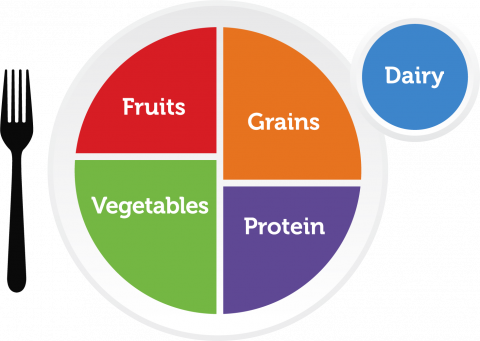Food Group Gallery
 MyPlate logo with food group labels" width="480" height="341" />
MyPlate logo with food group labels" width="480" height="341" />
The table below lists some foods in the Fruit Group. If you click on the hyperlinked foods, you will see a picture of a specific amount of that food that counts as 1 cup-equivalent of fruit — or in some cases ½ cup-equivalent.
Learn more about the Fruit Group.
Berries
acai berries
blackberries
blueberries
boysenberries
cranberries
dewberries
goji berries
gooseberries
huckleberries
lingonberries (cowberries)
loganberries
mulberries
raspberries
100% Fruit Juice
apple juice
cranberry juice
grape juice
grapefruit juice
mango juice
papaya juice
pineapple juice
pomegranate juice
prune juice
tangerine juice
Melons
cantaloupe
horned melon (kiwano)
watermelon
Other Fruits
Asian pears
Buddha’s hand
cactus pears
calamondin
dragon fruit
mangosteen
nectarines
passion fruit
persimmons
pomegranate
prickly pears
star fruit
tangerines
Vegetable Group
The table below lists some foods in the Vegetable Group divided into its five subgroups: Dark-Green Vegetables, Red and Orange Vegetables, Starchy Vegetables, Beans, Peas, and Lentils, and Other Vegetables.
Learn more about the Vegetable Group.
Dark-Green Vegetables
amaranth leaves
arugula (rocket)
beet greens
bitter melon leaves
broccoli rabe (rapini)
broccolini
chrysanthemum leaves
collard greens
dandelion greens
dark-green leafy lettuce
lambsquarters
mixed greens
mustard greens
poke greens
Swiss chard
taro leaves
turnip greens
watercress
Red and Orange Vegetables
acorn squash
butternut squash
hubbard squash
kabocha squash
pimento/pimiento
red and orange bell peppers
red chili peppers
red peppers, sweet
winter squash
Beans, Peas, and Lentils*
bayo beans
bean burger
black-eyed peas (mature, dry)
brown beans
chickpeas (garbanzo beans)
edamame (young soybeans)
falafel (spiced, mashed chickpeas)
fava beans (broad beans)
hummus (chickpea spread)
lima beans (mature)
mung beans
navy beans
pigeon peas
pink beans
split peas
white beans
Starchy Vegetables
breadfruit
burdock root
green bananas
green lima beans
green peas
lotus root
taro root (dasheen or yautia)
water chestnuts
Other Vegetables
alfalfa sprouts
artichokes
bamboo shoots
bean sprouts
bitter melon (bitter gourd, balsam pear)
broccoflower
Brussels sprouts
cactus pads (nopales)
chayote (mirliton)
drumstick pods (moringa)
fennel bulb
fiddlehead ferns
ginger root
green peppers
hearts of palm
Jerusalem artichokes (sunchokes)
luffa (Chinese okra)
pattypan squash
red cabbage
spaghetti squash
tomatillos
yellow squash
* Beans, peas, and lentils are also part of the Protein Foods Group.
For more information on beans, peas, and lentils, see Beans, Peas, and Lentils Are Unique Foods.
Grains Group
The table below lists some foods in the Grains Group divided into its two subgroups: Whole Grains and Refined Grains. If you click on the hyperlinked foods, you will see a picture of a specific amount of that food that counts as 1 ounce-equivalent of grains — or in some cases 2 ounce-equivalents.
Learn more about the Grains Group.
Whole Grains*
barley (not pearled)
bulgur (cracked wheat)
rolled oats
whole grain barley
whole grain cornmeal
whole grain sorghum
whole wheat bread
whole wheat cereal flakes
whole wheat chapati
whole wheat crackers
whole wheat pasta
whole wheat sandwich buns and rolls
whole wheat tortillas
Refined Grains*
breadcrumbs
challah bread
corn tortillas
cream of rice
cream of wheat
English muffins
French bread
pasta (spaghetti, macaroni)
pie/pastry crusts
pita bread
pizza crust
ramen noodles
refined-grain cereals
refined-grain crackers
rice cakes
rice paper (spring roll wrappers)
rice vermicelli
white bread
* These products are usually made from refined grains but some may also be made with whole grains. Check the ingredient list for the words "whole grain," "whole wheat," "whole corn," etc., to decide if they are made from a whole grain. Some of these foods may be made from a mixture of whole and refined grains.

 MyPlate logo with food group labels" width="480" height="341" />
MyPlate logo with food group labels" width="480" height="341" /> MyPlate logo with food group labels" width="480" height="341" />
MyPlate logo with food group labels" width="480" height="341" />